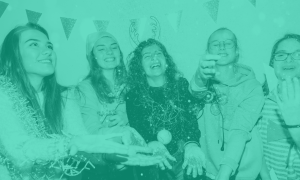
Reset Your Mindset and Beat the January Blues
For many people, January is a bit like the Monday of the year. It’s cold, the weather is gloomy and it definitely
Storytelling is a powerful tool for learning and what better time to celebrate that than the holiday season! A time when we are all sat around the TV, watching old Christmas movies, and hoping snow will cancel school tomorrow. We consume so many stories from books, TV, films, video games, and podcasts we listen to. We also share stories in the conversations you have with your friends and family. Stories are fun, but they are also amazing tools for learning. Did you know that storytelling can improve your memory? You can use them to memorise important facts for a test or things within your daily routine. All it takes is a little bit of creativity!
Believe it or not, but you’ve already used storytelling to help you remember things. For example, in your maths class, you might come across word problems like figuring out how much pizza each person gets at a party if you have 8 slices and 4 friends. The story makes the problem more relatable; you can imagine yourself in the situation. This makes it easier for us to understand the question and start to solve it, because it connects to real life.
Even when you were little, you probably learned things through stories. Remember the alphabet song? Think about how you as a young child watched shows on CBBC, with funny puppets singing songs about the alphabet. Most of us still remember the order of the letters because it’s tied to that catchy tune. This shows how stories and fun connections can make learning easier and help you remember things for a long time.
Our brain loves things that go in order. If I was to ask you to recall a journey that you make on a regular basis, you could probably do it easily. So, why not use this method to help you learn? By following an easy 3-step process you can create a memory journey that will help you remember key facts. Watch the video below to find out how.
A mnemonic is essentially a pattern that helps us connect information to something more memorable. A classic one is ‘Never Eat Shredded Wheat’ (North, South, East, West). Why not have a go at creating one yourself? It doesn’t need to be based on a previous story or even make sense.
For example, imagine that you need to remember to leave for school with your books, keys, glasses, lunch, and phone. You could create a little story like this to help you remember everything:
I booked a salad bowl full of chickpeas for lunch in a phone booth with a smashed glass window.
But where are the keys? Chickpeas! If you say it fast enough, it sounds close enough. Repeat this story over and over… you won’t ever forget what to take with you to school! There isn’t a rule to how your story should go. More often than not, the sillier the story is, the more likely you are to remember it. Use simple word associations and keep the sentence as short as you can – don’t overcomplicate things.
Perhaps you are more of a visual learner, work with that. Here is a storytelling method you might find easier to use. Imagine you are trying to remember the definitions of Sin, Cos and Tan.
Sin=Opposite/Hypotenuse.
Cos=Adjacent/Hypotenuse.
Tan=Opposite/Adjacent.
Put the letters of all these together and you get SOHCAHTOA… we think that sounds like the name of a volcano! Now use the image of a volcano to remember that formula. Or perhaps, for history class, you need to remember that it was not Prince Albert who introduced the Christmas tree to England but Queen Charlotte. So, picture Queen Charlotte with a Christmas tree being stolen by Albert Einstein dressed as the singer Prince!
You could draw a picture or try to make the image digitally, so you have a visual reminder to look back at. A poorly photoshopped photo can be both funny and easy to look at during revision. If that’s too technical don’t worry, you just need to be able to visualise the picture in your mind! This method is similar to creating a mind map of information with doodles, associating facts with images. Only this time, we are adding a story to make it even more memorable.
Stories are incredibly powerful for our personal growth. They can offer new perspectives, challenge ideas, and teach us information that can stick with us forever. They can be empowering and quite literally change the way we think! Storytelling is a tool and an ability that anyone can use, whether that is to express themselves or to create mnemonic devices to remember schoolwork.
If you’d like to learn more fun techniques like this, why not pick up a copy of our Smarten Your Study workbook. We share tools and techniques which help to make the boring stuff fun, the hard stuff easier and turn the ‘I can’t’ into I can! By having a little more fun when you learn, you will ultimately build up resilience, relieve stress and lead on a path to success!
Follow us on social media!

For many people, January is a bit like the Monday of the year. It’s cold, the weather is gloomy and it definitely

The start of a new year feels like the perfect time to make changes. Everyone’s talking about goals and resolutions, but here’s

So, Christmas is over. You’ve unwrapped the gifts, devoured the food, and binge-watched every festive movie under the sun. Now, here you